大学英语UnitAdvertisement教案
Unit10Lesson4Advertisements设计

Unit 10 Lesson 4 Advertisements 教学设计【教学目标】语言知识和技能方面:1.掌握有关广告的新单词。
2.学会运用广告里的形容词。
3.总结出广告写作的要素并运用。
【教学重点】本课是一节任务型读写课,“读”是为了“写”,“学”是为了“用”。
因此在整个教学过程中,让学生通过阅读,探究总结出好广告的要素和写作技巧,并加以运用,以组为单位在规定时间内根据教师所给材料和信息写出广告词,并让其相互评价,及时反馈。
【教学重点】通过课前和课堂上的体验、参与、实践等探究性活动,让学生学会合作、自主学习,增强学生学习的积极性和学生的自信心。
【课时安排】1课时。
【教学过程】一、导入新课:Step 1Leading inan advert on the screen. ( Pepsi Cola ).some adverts collected by the students and introduce three kinds of adverts briefly. Then tell the students today’s tasks.二、讲授新课:Step 2Readingreading. And ask them: “Which advert do you like best? Why?”the Reading Strategies box with the students.students read the four adverts again, and find out some opinions and facts to complete the table.some students to give the answers to the class. Explain some new words in the adverts.one advert as an example and ask them to sum up “What makes a good advert?” (4A)A creative idea.A clear title.A brief description.Attractive words.Step 3Writingthe class into groups. List the writing stages to direct the student to write an advert.them to use all the necessary information:What is it called?What can you use it for?Where can you use it?What is it made of?What are its advantages?How much does it cost?Where can you get it?a picture of Siemens mobile phone, and ask them to use the key words to write adverts in groups. ( music )students check their adverts.Step 4Presentationsome groups to show their adverts on the screen and read them out.some students to evaluate others’ adverts using the factors of good adverts, and then find out their problems and the way to improve.them the teacher’s idea.Step 5Conclusion & Homeworka brief sum-up.for today:Write an advert for a gadget following the writing stagesFinish the exercises in the workbook.Do the exercises in English Weekly.。
Unit-1--advertisements--教案设计

Unit 1Reading Advertisements 教案设计八滩中学季国东一,教材分析执教内容为高中牛津英语模块四第一单元Reading 板块的语篇“Advertisements”. 本单元一广告为话题,旨在让学生了解广告的定义,种类,做广告的方式及广告宣传的相关的知识。
Reading 部分是一篇说明文,结构清晰,由什么是广告,哪里可以见到广告入手,说到广告的两大主要类型,举例说明两类广告的目的和手段的区别,最后提醒读者用恰当的态度对待广告。
二,学情分析此话题贴近生活,学生比较熟悉和感兴趣,对文体的理解难度不大。
但是跟广告有关的词汇及如何用英语阐述一个广告及内涵会感觉困难。
同时,培养学生对不同类型的广告的警惕意识和推广意识。
三,设计思路本节课教学设计的总体流程为:1.what we see 2.what we learn 3.what we can do 4.express what we design.四,教学过程Step1 what we seelet's enjoy a video clip together. while watching, please try to remember as much information as you can.1.What did you see just now?2.How many ads did you see just now?3.Could you tell me some based on your memory?1. It seems that all students are so familiar with some ads.Why are you so familiar with them?2.Where else can we often see or read ads?3.Could you tell me what an ad is according to your understanding?Pay attention to the ads. what do they want to sell us?what do these ads have in common?Step2.what we learn1.Do you think ads tell us the complete truth?Read para.3 and answer:1.What are the two examples of CAs given by the writer inthis paragraph?2. How do CAs trick us according to these examples?Read para.4 and answer:1.What do PSAs aim to do?2.What are the examples of PSAs given by the writer in this paragraph?Since China began a nationwide public service advertising campaign 1n 1996, various types of PSAs have appeared.here is one that impresses me most.let's enjoy it togetherand tell me what message the PSA want to convey to us?Step3.what we can doHave you ever thought of designing an ad by yourself? Now you have got a chance. work in groups.Choice 1:Design an ad for your company's chocolate.Choice2: Design an ad for you club to make it famous and attract more students.As to how to design a good ad, you can turn to page 17 for reference (参考).Step4.express what we designStep5.Homework。
全新版大学英语教案Unit14 Advertising

Unit 14 AdvertisingObjectives: In this unit, we will make the students grasp some communicative skills and reflect on advertising.1. Help the students to gain some communicative functions, especially focuses on agreement and disagreement.2. Help the students to master some listening strategy, focuses on distinguishing signal words.3. Help the students to understand the general idea of the listening text and important details.4. Help the students to practice the discussion in relation to advertising.Time allotment: 2 periodsPart ACommunicative Function Agreement or DisagreementIn daily conversation, we often agree or disagree with other people's opinions. This exercise is focused on how we express agreement or disagreement.Listen to the conversations, paying attention to the ways people agree and disagree with the opinions expressed. Decide whether the second speaker agrees or disagrees with the first speaker.1. a. Agree b. Disagree2. a. Agree b. Disagree3. a. Agree b. Disagree4. a. Agree b. Disagree5. a. Agree b. Disagree6. a. Agree b. Disagree7. a. Agree b. Disagree8. a. Agree b. DisagreeScript1. --Do you think we should put an ad in the newspaper to sell our apartment?--Sure, why not?2. --Campus Daily isn't very interesting this week.--You can say that again.3. --I hear putting an ad in a newspaper costs a lot of money.--It depends.4. --In my opinion watching so many TV ads is a waste of time.--I couldn't agree with you less.5. --You don't care for commercials on TV, do you?--I'll say I don't.6. --Didn't you think the movie we saw last night was fascinating?--I wouldn't say that.7. --There'll be a football match between England and France on Channel 10 tonight.--Are you absolutely sure?8. --The design of the movie ads appeals to me very much.--You said it.Useful Expressions for Agreement and DisagreementExpressing Agreement●I agree entirely.●I couldn't agree with you more.●You can say that again.●I'll say / You said it.●That's it / You got it.●Why not?●That’s for sure/ Sure / Absolutely / Definitely / By all means / You bet.●That's just what I think / I feel the same way.●Me. too.●I think (guess / suppose ) so.●Exactly.Expressing Disagreement●I wouldn't say so.●I couldn't agree with you less.●No way.●It's out of the question.●I'm not sure I can agree.●I couldn't disagree more.●I disagree.●I don’t think so.●7. Are you absolutely sure?●I wonder if there's a mistake.●Are you kidding?NotesWe can express disagreement either directly or indirectly. You disagree directly when you are sure of the fact or when you think your opinion is more reasonable. Otherwise indirect disagreement often sounds more polite. "Are you absolutely sure?" and "I wonder if there's a mistake" are examples of showing disagreement indirectly.Listening StrategyDistinguishing Signal WordsWords like "but", "although" and "however" give a signal that the speaker (or writer) is going to say something different from what has been said. On the other hand, words like "and", "besides" and "also" only add something similar to what has been said. The ability to recognize these signal words while listening is a great help in understanding a text correctly.Listen to the short conversations and choose the right answers to the questions you hear. Example: --You like to go shopping in the supermarket, don't you?--Yes, it's so convenient. Besides, things are cheaper.Q: Does the woman enjoy shopping in the supermarket?a. Yesb. No1. a. Yes b. No2. a. Yes b. No3. a. Yes b. No4. a. Yes b. No5. a. Yes b. No6. a. Yes b. No7. a. Yes b. No8. a. Yes b. NoScript1. --How do you like our campus, John?--Well, it's very large but it's not clean enough.Q: Does John have a favorable opinion of the campus?2. --How do you like your English teacher, Li Ming?--She's very strict and her classes are always well-organized. Besides, she often givesup her free time for her students.Q: Does Li Ming like her English teacher?3. --How did you enjoy your vacation, Jack?--Although it was short, I visited many museums and art galleries.Q: Did Jack enjoy his vacation?4. --Michael, everybody says Professor Fall is a boring teacher. What do you think?--Everyone falls asleep in his class. And he's hard to talk to.Q: Is Professor Fall popular among his students?5. --What's your impression of New York, Barbara?--I really like the stores and the museums appeal to me, too.Q: Does Barbara like New York very much?6. --Do you like living on campus?--I think so. But sometimes the dorm is so noisy that I can't get anything done.Q: Does the woman have a completely favorable opinion of living on campus? 7. --Do you think you will major in medicine, Mary?--I think being a doctor means a lot of study and then working all sorts of hours.Q: Does Mary want to major in medicine?8. --How do you like living with your roommates?--Well, sometimes it's hard to share a room with others but you get along with yourroommates by compromising.Q: Does the woman get along with her roommates?Part BPre-listening TaskQuestions for DiscussionYou are going to talk about advertising. Read the following questions and discuss them with your partner.1.Do you think ads are necessary or a nuisance?2.Do you like watching or reading advertisements? Why or why not?3.Why do manufacturers spend so much money on advertising?4.Do ads influence you (or people in general) in buying things? How?5.Has any particular ad had an effect on you in your decision to buy something?6.Do you have anything to advertise?7.Suppose you've got some second-hand course books to sell, where would you place your adand how?Demo2. Do you like watching or reading advertisements? Why or why not?I’d like to watch advertisements on TV. The reasons are as follows: First, I can see the actual product as it is shown on TV. Second, I can see the demonstration of the product and how it is used. Lastly, the person who shows the product to the audience is usually a celebrity. So I can see the celebrity often by watching advertisements.3. Why do manufacturers spend so much money on advertising?Manufacturers are no fools. They spend so much money on ads because advertising is an effective way of their marketing products. When you want to sell something in the market, you have to tell as many people as you can so that they will become interested in what you offer. If somebody else has the same thing to sell in the market, then you will have to tell people that your goods are better than others so that people will choose yours. All manufacturers know this very well and that is why they spend large amounts of money on advertising.Language FocusHere are some sentences and structures that you might find handy in discussing the above questions:●I like / dislike watching / reading ads. They are amusing / interesting / vivid / fascinating /funny / persuasive / misleading / exaggerated…●I come across ads every time I turn on TV / radio / open a newspaper / magazine.●Ads are part of our life / something unavoidable no matter whether you like them or not.●To sell a product, the first thing to do is make it known to potential customers. That’s whymanufacturers are ready to spend a lot of money on advertising their products.●The cost of making ads is actually included in the prices of goods.●Ads provide us with useful information on commodities / services / jobs …●Ads influence us in the kind of goods we buy. When we do shopping, we automaticallychoose to buy advertised goods without hesitation.●With ads, we save a lot of time in shopping / choosing the kind of product we want / lookingfor jobs / getting better services …●Without ads, manufacturers may find it difficult to sell their products /make their productsknown to consumers.●Without commercial ads, newspapers, radio and television companies cannot survive.●TV commercials are a nuisance / waste of time / interrupt programs too frequently.●Ads take advantage of our longing for wealth / good looks / good health / comfort …●Ads exploit our fear of danger / growing old / falling ill …●I once put an ad in a local newspaper to look for a roommate/ to sell some used textbooks/ tosell some electronic appliances and it really worked.●I don’t want to spend money on ads. I always sell the books that I no longer use to asecond-hand bookstore.Listening TasksA ConversationPlacing an AdWord Bankclassification n. category 类别read v. to be worded 措辞utilities ( pl ) n. a service such as gas, water or electricity that is provided to the public公用事业matching a. agreeing in color or pattern with another thing和……相配的offer n. an amount of money that sb. is willing to pay for sth.出价run v. to publish in a newspaper, magazine 刊登take up v. to fill or use space or time, to occupy 占用ScriptPlacing an Ad(Ring …Ring … Sound of phone being picked up)John: Hello, Campus Daily, advertising department. This is John speaking.Maggie: Hi. I'm calling to place a couple of ads.J ohn: Sure. Under what classification?Maggie: Well, I'd like one in the "Roommates Wanted" section.J ohn: All right. And how would you like your ad to read?Maggie: It should read "Female roommate wanted for pleasant, sunny two-bedroom apartment on Fifth Avenue, three blocks from campus. Share rent and utilities. AvailableSeptember first. Call between 5 and 9 p.m. and ask for Maggie."John: Fine. And what about your other ad?Maggie: That one I'd like under "Merchandise for Sale", and I'd like it to read "Matching blue sofa and easy chair for sale, excellent condition, $350 or best offer. Call between 5 and9 p.m. and ask for Maggie." Did you get all that?J ohn: Uh, huh. You'll want your phone number on these, right?Maggie: Oh sure. Thanks for reminding me. It's 555-6792.John: And how long do you want these ads to run?Maggie: For a week, I guess. How much would that be?John: Let's see—it's $8 a week per line. Your two ads will both take up three lines, so that's $24 per ad.Maggie: All right.Language and Culture Notes1.Background information University and college students often run their own newspapers to keep the university community informed of what happens on campus. They cover major school events, notices issued by the school authorities, sports and entertainment news, and articles written by students to air different viewpoints. A special column called "classifieds", or "classified ads", is devoted to advertisements for jobs, accommodation news, sale of used things -- books, furniture, cars, etc.—under such headings as "Help Wanted", "Services", "Furniture for Sale", "Roommates Wanted", "Miscellaneous". To place an ad, one can call the advertising department of the paper to arrange it and pay a small fee. For example, a student-run paper at an American university in New York charges the following advertising rates: 8 dollars for the first 20 words, 25 cents for each individual word and 50 cents for a box.2. Campus Daily Name of a school newspaper3. How would you like your ad to read?What words would you like to put in your advertisement?4. Roommates Wanted A type of classified advertisement. You place your ad in this column in order to find others to share your apartment.5. utilities Supplies of water, gas, electricity and sometimes, telephone.6. Available September first. The earliest date for the roommate to move in will be September 1st.7. Matching blue sofa and easy chair The sofa and easy chair are of the same design and color8. ... or best offer Or highest price offered by a potential buyer9.it's $8 a week per line It costs $8 for one line to run /appear a week in the paper.Exercise 1: Listening for general understandingListen to the recording once and choose the right answers to the questions you hear.1. Who are the two speakers in the telephone conversation?a. A newspaperman and a reader.b. An advertising agent and a client.c. A real estate agent and a tenant.d. A shop assistant and a customer.2. What is Maggie doing in the conversation?a. She is applying to work for a newspaper.b. She is trying to sell her apartment through a local newspaper.c. She is running the ads column of a campus newspaper.d. She is having two ads run in a school newspaper.3. What can you infer about Maggie?a. She will graduate soon.b. She feels lonely living in an apartment all by herself.c. She will move out of a two-bedroom apartment.d. She might be unable to afford a two-bedroom apartment alone.Exercise 2: Listening for detailsListen to the recording once again and fill in the blanks with the missing information.Speaking TasksPair WorkListen to the conversations and repeat after the recording. Practise the conversations with your partner, playing the role of A or B. Then work with your partner to create your own conversationsPart CAdditional ListeningA Passage Different Kinds of AdvertisingListen to the passage and fill in the blanks with the missing information.ScriptDifferent Kinds of AdvertisingAdvertising is an important part of marketing. V ery few companies are able to sell a product without advertising. It is possible, but very unlikely. There are many different kinds of advertising. The simplest is called promotion. Promotion is using brochures or pamphlets to advertise. Theses can be handed to people on the street or they can be mailed. If they are mailed, it is called direct mail advertising. After direct mail advertising, there are: newspaper advertising, radio advertising, magazine advertising and television advertising. Newspaper advertising is the cheapest kind, while television is the most expensive.Television ads are generally used by large companies selling a product to a large market segment. Television advertising can be very successful because it reaches such a large audience. Small companies may find television advertising too expensive, so they often use newspapers to advertise. However, large companies also like newspapers because of their wide circulation.Movie TimeWatch a video clip. After watching it, read the paragraph summarizing the features of Ferrari. Fill in the blanks according to what you have got from the video clip.Word BankFerrari n. 法拉利one and a quarter tons 1.5吨(车重)sports car 跑车precision n. 精确性ultimate adj. 终极的fusion n. 熔合,联合conjure vt.(变魔术般地)变出aura n. 光环,气氛mystique n. 神秘性Formula One 一级方程式赛车大奖赛(全称Formula 1 Grand Prix,简称F1。
Unit1Advertising教学设计
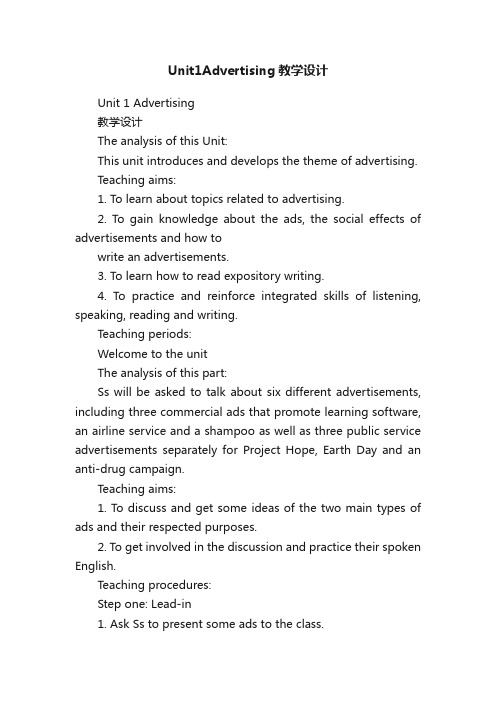
Unit1Advertising教学设计Unit 1 Advertising教学设计The analysis of this Unit:This unit introduces and develops the theme of advertising.Teaching aims:1. To learn about topics related to advertising.2. To gain knowledge about the ads, the social effects of advertisements and how towrite an advertisements.3. To learn how to read expository writing.4. To practice and reinforce integrated skills of listening, speaking, reading and writing.Teaching periods:Welcome to the unitThe analysis of this part:Ss will be asked to talk about six different advertisements, including three commercial ads that promote learning software, an airline service and a shampoo as well as three public service advertisements separately for Project Hope, Earth Day and an anti-drug campaign.Teaching aims:1. To discuss and get some ideas of the two main types of ads and their respected purposes.2. To get involved in the discussion and practice their spoken English.Teaching procedures:Step one: Lead-in1. Ask Ss to present some ads to the class.2. Discuss those ads3. Free talksa) Where do you find these ads?b) What are ads used for?Suggested answers:a) on billboards, TV, the radio in magazines/newspapers/leaflets given out in the streets.b) To promote a product or services, to believe in an idea.To educate people about health, safety or any other issue which affects public welfare.Step two: Picture talking:1. Project Hope---How do you feel when you see the child in the big eye?---What would you like to do for the child after seeing this ad?----What do you think the purpose of Project Hope is ?This picture is intended to make people aware of the importance of Project Hope.It makes people realize that there are still a lot of children dropping out of school for economic reasons. It calls upon people to do sth. to help children in poor areas. The picture makes us aware of the needs of other people.The purpose of Project Hope : It aims to help young people who have dropped out of school return to school. It aims to develop basic education in poor areas in child, especially in western china, with money collected from society. Nowadays it pays special attention to children of laid-off workers in cities.2. the software ad--- What do you know from this ad?--- If you intended to buy some cheap learning software,would this advertisement help you?3. Oxlin Airlines---- What does the advertisement try to sell a product or service?4. Earth Day----Why does this ad. Use the image of a bird’s nest?----Do you think this advertisement helps to make people aware of environmental problems?----What do you think Earth Day is all about ?Earth Day aims to increase environmental awareness and encourage people to take care of the Earth and its people. The first Earth Day was celebrated on 21 March, 1970. The reason why it fell on that day is that night and day are equal throughout the Earth on that day. Today Earth Day is celebrated annually by almost every country throughout the world.5. Say no to drugs---the anti-drugs campaign------Do you think drugs are harmful?------If someone takes drugs, what could happen to him or her?------Does the ad teach you about the bad effects of taking drugs?What are they?6. the Shampoo ad----what kind of people do you think this ad is targeting? Why?----Younger people, especially girls or females. Because they pay more attention to their appearance.---hair.------Do you think this ad will successfully persuade people to buy this shampoo? Step three: Discussion1. Ask Ss to discuss three questions in pairs or groups.2. summary.Step four: Language focus1. advertise ---advertising advertiser advertisement登广告:在公告,如报纸上询问或寻找:advertise for an apartment.登广告寻求公寓房2. make sb. aware ofWhat the teacher said made me aware of the importance of English.Be aware ofThe little child is not aware that he is faced with danger.You are not aware how worried I felt about your safety.3.dangerC/n Waste must be treated so that it does not become a danger to life.That man is a danger to society.C/n A soldier’s life is full of danger in war.In danger (of ) …. / out of dangerThe man is in danger because the tiger besides him is dangerous.4. similar be ~ toSimilarityThere are some similarities and differences between American English and Britain English.Your views on education are ~ to mine.5. may have doneHe may have missed his train.They may not have finished the work by now.Homework 1. preview reading part2. Translation1. 这家旅馆提供练好的服务。
英语教案-unin5 Advertise教学目标

英语教案-unit5Advertise教学目标一、教学目标1.知识目标:(1)学生能够掌握本节课的核心词汇,如:advertise,classified,section,notice,agency,column,headline 等。
(2)学生能够理解并运用本节课的语法点,如:情态动词should 的用法。
2.能力目标:(1)学生能够通过听、说、读、写的实践活动,提高英语实际应用能力。
(2)学生能够运用所学知识,独立完成广告设计的任务。
3.情感目标:(1)学生能够认识到广告在日常生活中的重要性。
(2)学生能够培养合作精神,提高团队协作能力。
二、教学重点与难点1.教学重点:(1)核心词汇的掌握与运用。
(2)情态动词should的用法。
2.教学难点:(1)广告设计的创意与实施。
(2)英语听、说、读、写能力的综合运用。
三、教学过程1.导入(1)教师通过展示一些有趣的广告图片,引导学生谈论广告的特点及作用。
(2)学生分享自己最喜欢的广告,并说明原因。
2.新课内容(1)教师展示本节课的核心词汇,让学生猜测词义,并进行解释。
(2)教师通过讲解和示例,让学生理解情态动词should的用法。
(3)学生听课文录音,回答相关问题,巩固所学内容。
3.课堂活动(1)教师将学生分成小组,每组选择一个广告主题,进行创意设计。
(2)学生通过讨论,确定广告的内容、形式和表现手法。
(3)每组学生展示自己的广告设计,其他学生进行评价。
4.练习与巩固(1)教师设计一些练习题,让学生运用所学知识进行填空、改写等。
(2)学生进行听力练习,听懂广告内容,回答问题。
(2)学生分享自己在广告设计过程中的收获和感受。
(3)教师布置课后作业,让学生运用所学知识,创作一篇广告文案。
四、课后作业1.学生运用所学知识,创作一篇广告文案,主题不限。
2.学生预习下一节课的内容,做好课前准备。
五、教学反思1.本节课教学过程中,学生对核心词汇和情态动词should的掌握情况如何?2.学生在广告设计活动中,是否能够充分发挥创意,提高英语实际应用能力?3.课后作业是否能够巩固所学内容,提高学生的写作能力?通过本节课的教学,教师应关注学生的学习效果,及时调整教学方法,以提高教学质量。
advertisements教案
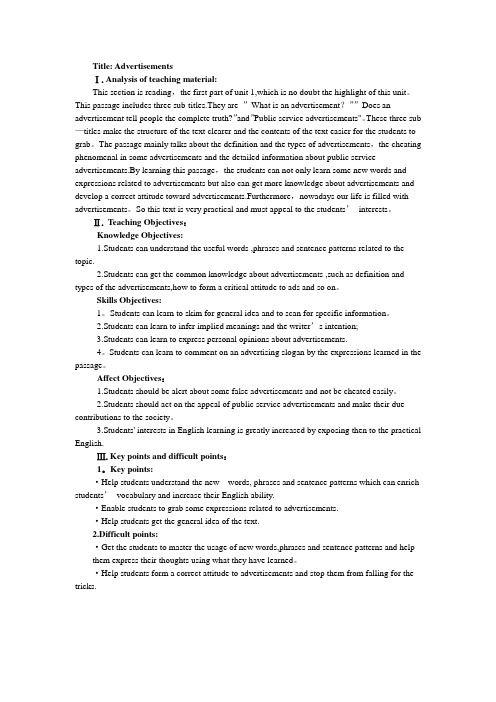
Title: AdvertisementsⅠ.Analysis of teaching material:This section is reading,the first part of unit 1,which is no doubt the highlight of this unit。
This passage includes three sub-titles.They are ”What is an advertisement?””Does an advertisement tell people the complete truth?”and”Public service advertisements"。
These three sub —titles make the structure of the text clearer and the contents of the text easier for the students to grab。
The passage mainly talks about the definition and the types of advertisements,the cheating phenomenal in some advertisements and the detailed information about public service advertisements.By learning this passage,the students can not only learn some new words and expressions related to advertisements but also can get more knowledge about advertisements and develop a correct attitude toward advertisements.Furthermore,nowadays our life is filled with advertisements。
基础模块下册Unit9Advertisement讲课教案

基础模块下册Unit9Advertisement讲课教案Unit9. AdvertisingI. 短语翻译1.被用来做某事2. 公众过去常常做 3. 引起, 使……成为习惯做某事 4. 通过, 借助于5. 等,等等6. 大量的, 许7. 或多或少9. 据说8. 例如可以说众所周知10. 在……中起作用11. 确信12. 实际上, 事实上II. 选择填空( )1. Our life condition has___ improved.A. moreB. lessC. more or lessD. more and less ( )2. We study many courses, ___ Chinese, maths English and so on.A. such asB. for exampleC. suchD. example( )3. She ___ a leading ___ in the play.A. take, partB. play, partC. took, roleD. played, role ( )4. We learn English ___ speaking.A. by means ofB. by mean ofC. in mean ofD. in means of ( )5. May I speak ___ Wang Lin.A. withB. toC. onD. in( )6. She ___ a white skirt for the party.A. selectB. selecttedC. selectingD. selected ( )7. The doors in this building will ___ white.A. paintB. paintedC. paintsD. painting( )8. She spent three days ___ her final papers.()A. readingB. to readC. readD. to reading( )9. I heard him ___ a song when I watched TV.A. singB. singingC. sangD. to sing( )10 I will have my car ___ tomorrow.A. repairB. repairedC. repairingD. to repair ( )11. I am looking forward to ____ you again.A. seeB. to seeC. seeingD. saw( )12. The boy ___ on the ground is my son.A. playedB. playingC. playD. to play( )13. Have you read the novel ___ by Lu Xun?A. writeB. writtenC. writingD. to write( )14. Would you mind ___ there?A. my smokingB. my smokeC. smokeD. smoked( )15. John was made ___ the car for a week as a punishment.A. washB. to washC. washingD. to be washing ( )16. ___ into the house, she lit a candle.A. StepB. Having steppedC. SteppedD. Being stepped ( ) 17. We have nothing___.A. eatB. eatingC. to eatD. to be eaten( )18. The house needs___.A. repairB. repairingC. repairedD. to repair( )19. ___, the kids in the nursery keep healthy.A. Take care ofB. Being taken careC. Being taken careD. Taking care( )20. She stood there ___ the children playing games.A. to watchB. watchingC. watchedD. watches( )21. Many seasons in England are worth ___ in all seasons.A. visitB. visitingC. to visitD. visited( )22. We can’t do it, please ask somebody ___ us.A. helpB. helpingC. to helpD. helped( )23. Would you like___ some wine/No, thanks. I don’t feel like___ anything now.A. having, drinkingB. to have, to drinkC. having, to drinkD. to have, drinking( )24. Do you enjiy___ English in our class, Mr Green.A. teachB. taughtC. to teachD. teaching( )25. We’re in class, you’d better not___.A. talkB. talkingC. talkedD. to talk( )26. How about ___ to the cinema on Sunday.A. goB. to goC. goingD. will go( )27. He has a sister___ Amy.A. callingB. calledC. to callD. be called( )28.This news sounds ___.A. excitingB. excitedC. exciteD. to excite( )29. I feel very tired.Why not stop ___.A. to workB. to have a restC. having a restD. to go on with the work( )30. It is no good ___ the book.A. readB. readingC. to readD. reads( )31. Mary, your English is very good.A. Not goodB. Thank youC. So are youD. It’s bad( )32. I am sorry for knocking your books off your desk.A. It does n’t matterB. I am glad to。
[推荐精选]Unit 10 Lesson 4 Advertisements上课学习上课学习教案
![[推荐精选]Unit 10 Lesson 4 Advertisements上课学习上课学习教案](https://img.taocdn.com/s3/m/6f372990f524ccbff1218460.png)
Unit 10 Lesson 4 Advertisements教案Unit10Lesson4Advertisements教案(北师大版必修模块4)一、教学内容分析(AnalysisofPositionandcontent)、本课是阅读课,重点培养学生的阅读能力,是本单元中的重点。
2、在理解本课的基础上,可以更好的接受下一课对语言知识点的学习。
二、学生学习情况分析《高中英语新课程标准》明确指出:“高中英语课程要有利于学生优化英语学习方法,使他们通过观察、体验、探究等积极主动的学习方法,充分发挥自己的学习潜能,形成有效的学习策略,提高自主学习的能力。
”根据《高中英语新课程标准》要求,结合我班学生英语基础与能力较弱的实际,本课时我把阅读课文作为整体处理的同时,把每个教学环节所设计的问题和任务区分出高低不同的层次,由浅入深,循序渐进,使每个教学环节尽量符合多数学生的认知水平,力争全班绝大多数同学都能积极参与课堂活动。
通过“任务型”活动培养学生“跳读”、“寻读”、“定位”、“推理归纳”等阅读方法以及描述、讨论等组织语言、运用语言的能力。
三.设计思想课堂教学方法的选择是课堂教学效率高低的关键。
科学的学法指导是智能发展目标得以实施的重要途径。
现根据教师本人的自身特点和泉州现代中学高一年段的实际教学条件,结合本课的教学内容:advertisements,概述教学过程中拟实践的教育理念、教学原则、教学方法。
在本课教学中,我突出以阅读为主线,兼顾结构,适当拓展。
从以下几方面体现了英语新课程的理念。
、演示法:把制作的、图片等显示给学生看,便于学生对微观知识的把握,并从旧知识中获得启迪,从而达到解决问题的目的。
2、任务驱动教学法:将所要学习的新知识隐含在一个或几个问题之中,学生通过对所提的任务进行分析、讨论,并在老师的指导和帮助下找出解决问题的方法,最后通过任务的完成而实现对所学知识的意义建构。
以“任务型”教学作为课堂教学设计之理念,具体采用分层次教学法和交际教学法。
Unit1AdvertisingWelcometotheunit设计3
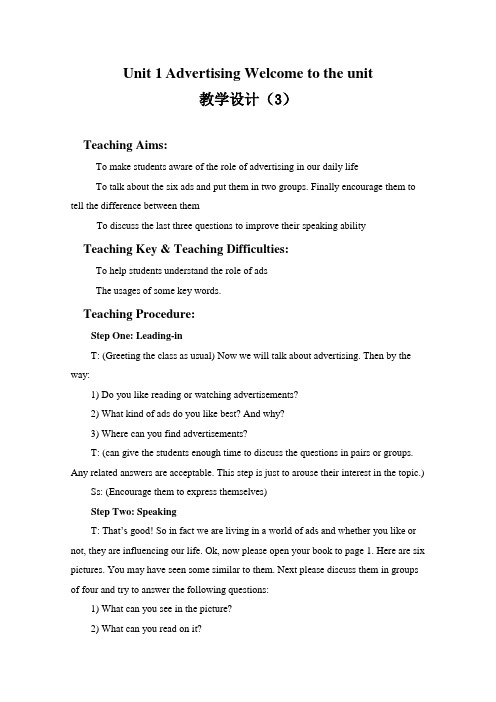
Unit 1 Advertising Welcome to the unit教学设计(3)Teaching Aims:To make students aware of the role of advertising in our daily lifeTo talk about the six ads and put them in two groups. Finally encourage them to tell the difference between themTo discuss the last three questions to improve their speaking ability Teaching Key & Teaching Difficulties:To help students understand the role of adsThe usages of some key words.Teaching Procedure:Step One: Leading-inT: (Greeting the class as usual) Now we will talk about advertising. Then by the way:1) Do you like reading or watching advertisements?2) What kind of ads do you like best? And why?3) Where can you find advertisements?T: (can give the students enough time to discuss the questions in pairs or groups. Any related answers are acceptable. This step is just to arouse their interest in the topic.) Ss: (Encourage them to express themselves)Step Two: SpeakingT: That’s good! So in fact we are living in a world of ads and whether you like or not, they are influencing our life. Ok, now please open your book to page 1. Here are six pictures. You may have seen some similar to them. Next please discuss them in groups of four and try to answer the following questions:1) What can you see in the picture?2) What can you read on it?T: Wonderful. I think most of you have realized the difference between the two. And in the reading we will have a further discussion.Step Three: DiscussionT: So, now look at the three questions and discuss them in groups of four.1) Have you ever bought a product or service after reading or watching an ad?2) What was it? Now do you believe that advertisements tell the complete truth?3) What is/are your favorite advertisement(s) making you think about problems in society or about people who need help? Why?4) What do you think makes a good advertisement?Ss: …(T can help the students to conduct the activity and encourage them to work together to complete the task. Later let some students to show off.)T: Well done. Now I think most of you have know what an advertisement is and realize the role of them in our life.Step Four: Language Points1) advertise vt. 为……登广告、做宣传vi. 登广告advertisement= ad n. 广告put an advertisement 登广告advertise for … 登广告征聘……. The company is advertising for a new manager.2) be aware of …知道、明白、意识到……be/seem aware that … 察觉、发觉、发现……. Everybody is aware of the importance of protecting rare animals.. Buried in deep thought, Tom wasn’t aware of what happened around him.. Nowadays, people seems aware that some products don’t stick to the promises of their advertisements.3) think about … 考虑……think of … 想起、想到……think out … 想出……think over 仔细考虑Step Five: Homework1. Ask students to read the passage in Part B on page 95 in workbook as their homework. Teachers can check the answers in or after class2. Let them preview the next period, especially the new words in the instructions or requirements but not included in the wordlist.。
unit3Advertising教案
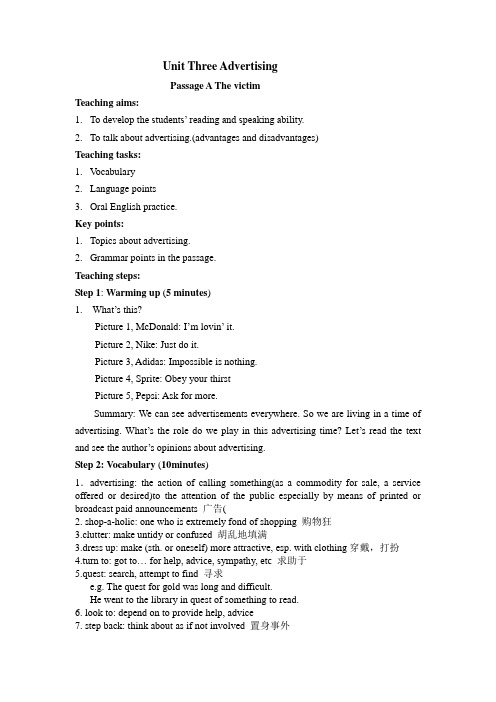
Unit Three AdvertisingPassage A The victimTeaching aims:1.To develop the students’ reading and speaking ability.2.To talk about advertising.(advantages and disadvantages)Teaching tasks:1.V ocabularynguage points3.Oral English practice.Key points:1.Topics about advertising.2.Grammar points in the passage.Teaching steps:Step 1: Warming up (5 minutes)1. What’s this?Picture 1, McDonald: I’m lovin’ it.Picture 2, Nike: Just do it.Picture 3, Adidas: Impossible is nothing.Picture 4, Sprite: Obey your thirstPicture 5, Pepsi: Ask for more.Summary: We can see advertisements everywhere. So we are living in a time of advertising. What’s the role do we play in this advertising time? Let’s read the text and see the author’s opinions about advertising.Step 2: Vocabulary (10minutes)1.advertising: the action of calling something(as a commodity for sale, a service offered or desired)to the attention of the public especially by means of printed or broadcast paid announcements 广告(2. shop-a-holic: one who is extremely fond of shopping 购物狂3.clutter: make untidy or confused 胡乱地填满3.dress up: make (sth. or oneself) more attractive, esp. with clothing穿戴,打扮4.turn to: got to… for help, advice, sympathy, etc 求助于5.quest: search, attempt to find 寻求e.g. The quest for gold was long and difficult.He went to the library in quest of something to read.6. look to: depend on to provide help, advice7. step back: think about as if not involved 置身事外Phrases from the passage:1. a lover of fashion 时尚爱好者3. name-brand items 名牌产品4. get what sb. pays for 物有所值5. a victim of advertising 广告的受害者6. preppy all-American girl 干净利落的典型美国女孩7. snobby rich girl 自命不凡的富家千金8. upcoming style 最新潮流9. underlying images 潜在信息10. societal definitions 社会含义11. a certain look 特定类型Step 3: Text Learning (25 minutes)1. Now let’s look at the text (the whole class) and find out the outline of the passage.(10 minutes)Part I (para.1) : Introduction.Part II (paras.2-4) : The author’s own experience.Part III (para.5) : The autho r’s analysis of advertisers’ and customers’ psychology. Part IV (Para. 6): Conclusion.2. Interactive Activities(Group work): (15 minutes)Divide the students into 3 groups and talk about the topics below:Periods Attitude towardsClothes Influence of ad. My experienceand opinionIn my childhood In middle school In collegenowAnswers:Periods Attitude towards Clothes Influence of ad. My experienceIn my childhood What my mother gave me or thehand-me-down from my sister.Never questioned how I looked,but I liked to dress upNo influenceIn middle school Became concerned with my appearanceStill noIn high school Wanted to look good. Theclothing became something thatdefined a personBig influenceIn college Clothing begins to define aperson less and less. It showsone’s personality. It reflects andnot define a person.Remain a victimof ad.now Name-brand clothes clutter myroomNever stopped toquestion whetherI’m getting whatI’m paying for.I’m still a victimof ad.Step 4: Language points in the text. (25 minutes)3. Explain some sentences and language points.(25 minutes)△You could call me a shop-a-holic… a lover of fashion:You could call me a shopping addict, as most of my friends do, but I’d rather sa y I love to buy things in fashion.△But as I progressed to high school, advertising became a big influence:But as I moved ahead to high school, I paid more attention to advertising.△The clothing in high school became something that defined you:High school students seem to adopt a notion that by wearing expensive clothes they are wealthy, smart, or superior in some way.△Yet my friends and I still turn to advertising… to find our own style:Yet my friends and I still pay attention to advertising, not only to follow the fashions, but more to find our own personal style.△Advertisers show us people around us, yet they choose only a certain look: We see average people in the advertisements, but they are shown in deliberately chosen images.△Advertising feeds off human insecurities and make us want to be like these beautiful people.Advertising makes people insecure about who they are and need expensive clothes to make them look good.△Is it the victim’s fault …to do so?Is it the buyer’s fault for believing the advertising, or society’s fault for allowing ads to be made so powerful and influential?a)5) Ask the students to master the following words and phrases with the helpof the dictionary.clutter, dress up, quest, look to, step back, etc.Details:△clutter: make untidy or confused 胡乱地填满e.g. The room was cluttered with furniture.The road was cluttered with refugees.△dress up: make (sth. or oneself) more attractive, esp. with clothing穿戴,打扮e.g. They dressed up for the occasion.Are you going to dress up for the party, or is it informal?△turn to: got to… for help, advice, sympathy, etc 求助于e.g. I had to turn to the dictionary for help.The child felt there was no one he could turn to with his problems.△quest: search, attempt to find 寻求e.g. The quest for gold was long and difficult.He went to the library in quest of something to read.△look to: depend on to provide help, advicee.g. We look to you for help/to help us.An able young man is ashamed to look to others for assistance.△step back: think about as if not involved 置身事外e.g. From time to time, the teachers should step back and let their pupils runthings their way.6) Help them to summarize the text.Step 5: Debate & Exercises(25 minutes)1. Debate: Is advertising good or bad for our society?This competition not only provides a stage for students to develop their debating skills but also makes them more confident in expressing their thought in a foreign language.Step 1. PreparationStep 2. Position Presentation-ProPosition Presentation-ConStep 3. Free debateRebuttal & Response- ProRebuttal & Response- Con(all speakers -- questions & answers)Step 4. Conclusion: Position Summary- ProPosition Summary- Con2. Summary:The author once was a compulsive shopper, and might even be addicted to shopping. She tended to buy more clothes than she needed, and often looked for famous brands. She thinks she played a role of victim in that time.In my opinion, advertising can be find everywhere.No matter we are young or old, we are all target people for advertisers. It plays an important role in our life. Sometimes it could be fun.Sometimes it maybe a nuisance.However, we still need excellent advertisement to decorate our life. Just like the advertisement in 2010 Expo in Shanghai:"Better city, better life!"3.Exercises: Do the exercises 2-8.4.Homework:Find out five interesting Chinese advertisement in your life and translate them into English.。
Advertisements教案
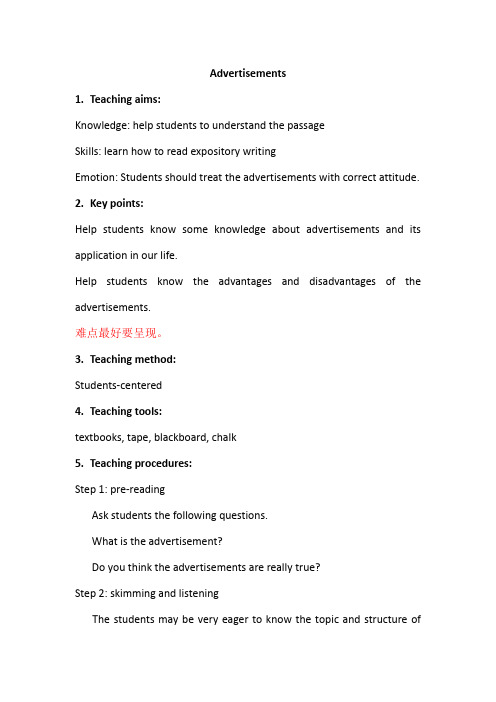
Advertisements1.Teaching aims:Knowledge: help students to understand the passageSkills: learn how to read expository writingEmotion: Students should treat the advertisements with correct attitude.2.Key points:Help students know some knowledge about advertisements and its application in our life.Help students know the advantages and disadvantages of the advertisements.难点最好要呈现。
3.Teaching method:Students-centered4.Teaching tools:textbooks, tape, blackboard, chalk5.Teaching procedures:Step 1: pre-readingAsk students the following questions.What is the advertisement?Do you think the advertisements are really true?Step 2: skimming and listeningThe students may be very eager to know the topic and structure ofthe text. Thus I ask them to read the text quickly and try to find answers to the three questions in Part A.Then check the answers with the class.Step 3: further readingWith part a finished, students may know the topic and structure of the text. This is very useful for them to further understand the text. During this period, they will get more information about the text by listening to the text and doing part c1 and part c2.1.Ask the students to read through the exercises on page 4.2.Ask the students to listen to the text attentively and try to getmore information.3.Ask the students to look at part c1 and choose true or false andcheck the answers (as a class.)---the whole class together.4.Ask the students to look at part c2 and answer this five questionsand then check the answers.Step 4: read the text again and conclusion this text.结论是什么?6.HomeworkWriting an article about the advantages or disadvantages of the ads.总评:1. 引入过于突兀,两问题之间联系太远。
新模式英语lesson2-advertisement说课稿

UNIT 2 CONSUMER SMARTSLesson 2 Advertisements一、说大纲根据《高级技工学校英语能力课程教学方案》所制定课程目标中新模式英语模块三的要求,学习本册书学生应该能够“掌握本模块所设定的英语环境下的生活技能”,“有条理地描述个人体验和表达个人见解”,“听懂语速为每分钟140词左右的故事或记叙文”。
教师要充分调动学生的学习热情,促进学生对英语的领悟与感受,让每个学生都能在更宽广的领域去充分接触英语感受英语。
二、说教材1.教材内容:本课选自《新模式英语3》Unit 2 Consumer Smarts消费者智慧里的第二课lesson 2 Advertisements 广告。
整个单元围绕“消费”话题展开。
单元的第一课是shopping for goods and services(购买商品和享受服务),是对本单元话题的一个导入,是本单元词汇教学的重点,第二课是advertisement(广告),是本单元的难点所在,也是本堂课的主要话题,透过简单的广告语,折射出的是一种文化背景和思维方式,其中有中西文化的融合也有文化的碰撞,在这个过程中学生能充分体会到中、英文的魅力所在。
2.教材的地位和作用: 我所要讲的Unit 2 Consumer Smarts 在全书的位置比较靠前,属于“英语环境下的生活技能”范畴,而其中Advertisements一课又介于生活技能与文字应用技能之间非常重要的一课。
因为语言作为文化的载体有着它固有的文化传播的功能,而广告用语又是任何一种语言的精炼和提纯,比如经典的广告用语:Impossible is nothing(Adidas广告)、Just do it(Nike 广告)、We are the champion(安踏广告)、To be No.1(鸿星尔克)、I’m loving it(麦当劳广告)等等,它们内含丰富,短小精悍,而且很容易被大家记住。
1教学方法在第2册Unit10 Advertisenment中的应用
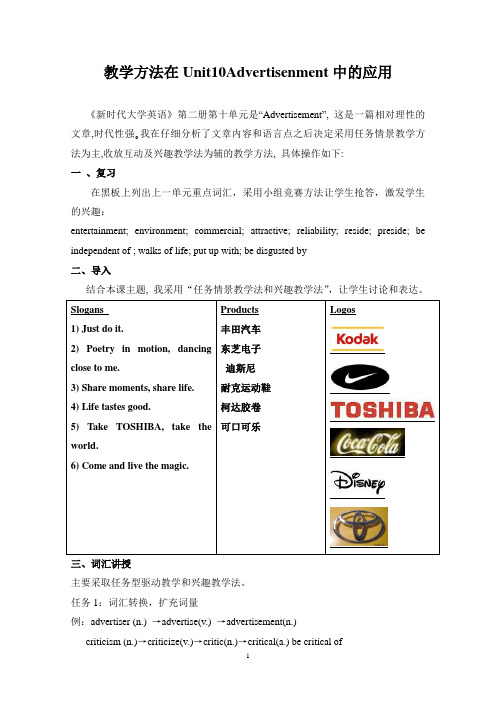
教学方法在Unit10Advertisenment中的应用《新时代大学英语》第二册第十单元是“Advertisement”,这是一篇相对理性的文章,时代性强。我在仔细分析了文章内容和语言点之后决定采用任务情景教学方法为主,收放互动及兴趣教学法为辅的教学方法, 具体操作如下:一、复习在黑板上列出上一单元重点词汇,采用小组竞赛方法让学生抢答,激发学生的兴趣:entertainment; environment; commercial; attractive; reliability; reside; preside; be independent of ; walks of life; put up with; be disgusted by二、导入结合本课主题, 我采用“任务情景教学法和兴趣教学法”,让学生讨论和表达。
三、词汇讲授主要采取任务型驱动教学和兴趣教学法。
任务1:词汇转换,扩充词量例:advertiser (n.)→advertise(v.)→advertisement(n.)criticism (n.)→criticize(v.)→critic(n.)→critical(a.) be critical of任务2. 汉英结合,音节记忆。
Precisely, supposing, detail, gaze, witty, source任务3:设置情境,短语应用。
情景如下:根据汉语所设情景,让学生用英语串联。
在我们日常生活中,广告无处不在,有些批评家认为广告善于自我推销,过于夸大事实,有些电视观众也认为广告占据了太多的时间,所以广告遭到了很多批评。
实际上,广告对我们的影响很大,我们应该积极地对待这个问题,让其对社会对消费者作出有益的贡献。
(in our daily life, advertising, critics, self-promotion, TV audience, account for, come in for, criticism, as a matter of fact, make a ... difference to, make a contribution to)任务4:练习巩固,加强记忆。
大学英语_Unit Advertisement_教案

21世纪大学英语应用型综合教程
Subject
Unit6 Advertisement
Students
Content
PartA-C
Time allotment
8 periods
Objectives
1、Knowledge aim: Words and expressions marked CET 4/6 in the page145-147、
nguage Focus&Reading in Depth(1 period)
V.Text B:Create an Effective Advertising Message(1 period)
VI.Translation of the Passage(1 period)
VII.Skill Development: Grammar & Video-Based Writing(1 period)
Example: The visit was aimed at expanding the relations between the two countries、
访问得目得就是扩展两国得关系。
Paragraph 1
1、Planting your child in front of a television set is not altogether a bad thing, provided that you limit the time that your little one spends watching TV and you monitor the programs watched、
Step 2: First listening and check
Unit 9(2) Advertisement 学案
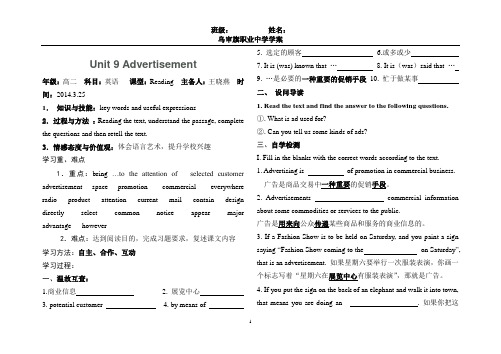
乌审旗职业中学学案1Unit 9 Advertisement年级:高二 科目:英语 课型:Reading 主备人:王晓燕 时间:2014.3.251. 知识与技能:key words and useful expressions2.过程与方法 :Reading the text, understand the passage, complete the questions and then retell the text.3.情感态度与价值观:体会语言艺术,提升学校兴趣 学习重、难点1.重点:bring …to the attention of selected customer advertisement space promotion commercial everywhereradio product attention current mail contain design directly select common notice appear major advantage however2.难点:达到阅读目的,完成习题要求,复述课文内容 学习方法:自主、合作、互动 学习过程: 一、温故互查:1.商业信息2. 展览中心3. potential customer4. by means of5. 选定的顾客6.或多或少7. It is (was) known that … 8. It is (was )said that … 9. …是必要的一种重要的促销手段 10. 忙于做某事 二、 设问导读1. Read the text and find the answer to the following questions. ①. What is ad used for?②. Can you tell us some kinds of ads? 三、自学检测I. Fill in the blanks with the correct words according to the text. 1. Advertising is of promotion in commercial business. 广告是商品交易中一种重要的促销手段。
- 1、下载文档前请自行甄别文档内容的完整性,平台不提供额外的编辑、内容补充、找答案等附加服务。
- 2、"仅部分预览"的文档,不可在线预览部分如存在完整性等问题,可反馈申请退款(可完整预览的文档不适用该条件!)。
- 3、如文档侵犯您的权益,请联系客服反馈,我们会尽快为您处理(人工客服工作时间:9:00-18:30)。
Unit6Text A:The Effects of TV Advertising on Children
2 periods (90 minutes)
Teaching procedures:
Para.1:General introduction
Para.2-7:The major effects of advertising on children.
Para.8:Conclusion
教学反思:
2 periods (90 minutes)
Teaching procedures:
III.Text A: DetailedReading
Skimming and scanning skills
Skills of writing an outline
Teaching Difficulties
Predict the missing content of a listening material with the help of the context.
1. According to some studies, the more children view tobacco and alcohol ads, the more positive attitudes toward consumption of such products they have.
II.Text A:Global Reading(1 peቤተ መጻሕፍቲ ባይዱiod)
Step 1: First reading:Read the text and answer the following questions.(10 mins)
1.How has the influence of advertising on our lives changed over the years?
Cultural note:The Media Awareness Network is a Canadian non-profit organization based inOttawathat focuses on media literacy programs. In particular, the organization promotes critical thinking via education resources and analyzes the content of various types of mass media. Surveys and studies performed by the Media Awareness Network have explored youth media consumption, such as television and internet use, as well as media issues. In recent years the organization’s focus has shifted more heavily to digital literacy, although it continues to produce resources on traditional media.
Examples:
The nuclear weapons are targeted onWestern Europe.这些核武器的目标是西欧。
What’s the target readership of this paper?这份报纸以哪些人为读者对象?
2.aim at
— make an effort towards
5.What measures can be taken to reduce the influence of advertising on children?
Step 2: Second reading:Text A has 8 paragraphs. Which paragraph contains the following information? Fill in the blanks with the corresponding paragraph numbers.(10 mins)
Structural study of complicated sentences in text A and B
Teaching Methods
Task-based teaching method
Audio-visual method
Communication method
Teaching Tools
3. Ideological aim:
1) Know some basic knowledge aboutadvertisement.
2) Helpstudents toread between the lines whilewatching advertisements.
Teaching Focus
Step 3:Structure of text A(25mins)
Para.1:General introduction
Para.2-7:The major effects of advertising on children.
Para.8:Conclusion
Blackboard Design:
Step 2: The teacher makes explanation on unfamiliar pronunciations and corrects the wrong pronunciations and then asks Ss to read the words and expressions after him/her three times.
3) Writing skill: Be able to write anadvertisementwith correct formatand expressions.
4) Translating skill: Be able to work out the equivalent English expressions of Chinese expressions independently.
本句的主句是“Planting your child in front of a television set is not altogether a bad thing”,provided that相当于if,表示“假如”,引导出一个条件状语从句。
2.Media Awareness Network
III.Text A:Detailed Reading (2 periods)
nguage Focus&Reading in Depth(1 period)
V.Text B:Create an Effective Advertising Message(1 period)
VI.Translation of the Passage(1 period)
Step 2: First listening and check
Step 3: Second listening and check
Step 4: Third listening and check
Step 5: Make Explanation of the material and some of the missing words.
2. Parents should teach their children to think critically about any advertising message.
3. Advertising makes children convinced that they’re inferior if they don’t have a certain kind of new products.
blackboard, multi-media, PPT
Teaching Procedure
I.Words and Expressions & Warm-up Listening(1 period)
II.Text A:The Effects of TV Advertising on Children(1 period)
I.Words and Expressions & Warm-up Listening(1 period)
. Words and Expressions(20 mins)
Step 1:Somestudents are asked to read the words and expressions to find out the unfamiliar or wrong pronunciations.
. Warm-up Listening(25 mins)
Step 1: Read the listening material to 1)get the main idea; 2) predict the words and the part of speech of the words missed in theblank according to the context.
Example: The visit was aimed at expanding the relations between the two countries.
访问的目的是扩展两国的关系。
Paragraph 1
1.Planting your child in front of a television set is not altogether a bad thing, provided that you limit the time that your little one spends watching TV and you monitor the programs watched.
